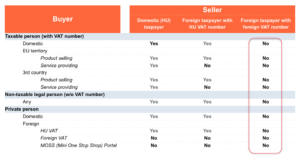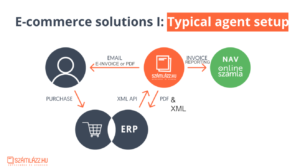New invoicing rules in Hungary for 2021: Real Time Invoice Reporting explained
New invoicing rules in Hungary for 2021: Real Time Invoice Reporting explained
From January 2021 new rules apply for the Hungarian online invoicing system that have a huge impact on e-commerce exporters. This article is dedicated to the Real Time Invoice Reporting in Hungary and all the details you need to know: understanding the basic principles, to whom it may concern and two possible workarounds from a low-entry self-service solution to a high-end tailored ERP integration.
On 3rd December with Growww Digital we have organised a webinar dedicated to RTIR. For those interested a quick recap/summary read the article below. If you wish to hear out a more detailed version, watch the full, 1-hour footage here:

What is Real Time Invoice Reporting?
It is a new obligation proposed by the Hungarian tax authority (HU TA/NAV) for submitting all the invoice reports with the main goal of reducing tax avoidance and whitening the economy. So far it has proven to be effective, since during the last 2 years share of the ‘grey economy’ in Hungary has decreased from 27% to 21-22%.
The introduction of RTIR has started 2 years ago, with a gradual rollout:
- Jul 1 2018: obligation of reporting of all invoices above value of 100k HUF
- Jul 1 2020: obligation of reporting all B2B invoices
- Jan 1 2021: extended obligation of reporting all B2C invoices
Connection with the Hungarian tax authority (HU TA) is purely online – there is no possibility of manual/offline reporting. Each user will have to register at the HU TA system and create a technical user in order to send data to the online platform. The HU TA will return a status of each report for invoices sent. The VAT data report will take place immediately and electronically, without any human intervention.
Main RTIR developments for 2021
- All resident taxpayers must use XML version 3.0 in their online invoicing reports.
- Businesses registered in Hungary for VAT purposes will have to report the invoices they issue to individuals (B2C) as well.
- Businesses must declare export invoices, both intra- and extra-EU.
To whom new Hungarian invoicing rules may concern?
In short, the RTIR obligation will affect all businesses that possess a Hungarian VAT ID. Exporters have an obligation to get a HU VAT ID if their yearly turnover exceeds 35k EUR. For the detailed scenarios when to report and when not to report find the table below:
Source: Szamlazz.hu

Timeline
As mentioned above, the obligation to report B2C invoices – the part impacting e-commerce exporters the most – is valid from Jan 1 2021.
IMPORTANT: The Ministry of Finance has granted a sanction-free three months grace period from 1 January to 31 March 2021 allowing businesses more time to comply with these new reporting obligations. This will also help with the transition from the current v2.0 XSD real-time reporting to the latest v3.0 XSD, which will be mandatory from 1 April 2021. For now, it is uncertain if there will be a requirement to retroactively report the transactions not declared during the grace period.
EU One Stop Shop (OSS) solves it all in the long-run
There will be another important change from 2021: the European Commission amended VAT regulations allowing Member States to prepare themselves for the introduction of the One Stop Shop (OSS); set to launch on 1 July 2021. The OSS aims to simplify submitting VAT returns (also by not being obliged to register in every EU country) and paying the correct country specific VAT for online retailers in the various Member States where they trade.
Tip: bearing in mind the upcoming EU OSS solution, and its launch on Jul 1, multi-country exporters basically need to ‘cover’ just the 3-month period of Q2 in 2021 with the Hungarian RTIR.
Solutions
We have brought you 3 different solutions to comply with the RTIR in Hungary – from a low-entry self-service system to a tailored solution. For the DIY types there is a step-by-step guide as a 3rd option.
Solution #1 – the self-service system
Balázs Ángyán, CEO of Számlázz.hu, the market leading online accounting SaaS solution in Hungary with 460k active clients introduced their own API-based solution for RTIR: Invoice Agent

Invoice agent is a non-browser-based interface of the Számlázz.hu system, that receives XML messages and depending on the received information. It can create invoices, reverse invoices, register credit entries, query invoice pdf files, query invoice xml files, etc. With API documentation easy to connect with your webshop, it results in significant cost savings, plus there are no errors, therefore you do not need to make corrections subsequently. Through API you only need to provide the billing data and with that information Számlázz.hu will create an invoice for you that complies with the regulations, send it to NAV and forward the data in XML and PDF to the webshop.
Important note: with Invoice Agent solution, the invoice is being issued by Számlázz.hu as the primary system, the invoice number being generated by Számlazz.hu. In case you need to connect it to your ERP system – and maintain data integrity of invoices across all systems -, further integration is needed.
Tip: Shoptet is currently working on the integration of Számlázz.hu’s Invoice Agent. According to their statement it will be available on their app store (“doplnky”) in Q1 2021.
Third-party invoicing and self-invoicing is recommended for those who have too many vendors, and the invoices issued to the company are filled in incorrectly too often, or who employ agents and pay them commissions on a monthly basis.
Solution #2 – the tailored solution
Lilla Németh, Director of tax services at RSM introduced their company’s online invoice reporting solution. Their cloud-based platform, Connectax solutions and software modules are easily and quickly connectable to partners’ current ERP, accounting and invoicing systems.
In case you maintain your current invoicing program, RSM advise you how to adjust your currently available XML file of your sales invoices, thus you will be able to fulfil the HU TA requirements. RSM has also an IT software solution: you send them the proper XML file and their software will communicate directly with HU TA, save the feedback and let you know the status of the online reporting.
The main difference compared to Számlázz.hu’s solution is that in RSM’s Connectax case your ERP remains the primary system for issuing the invoice. Connectax serves as an online connector between your ERP and the HU TA.
More detailed information about Connectax and its features can be found on RSM’s EN website.
Solution #3 – for the DIY types
Unfortunately there is no guide by the Hungarian tax authority in English but thanks to Számlázz.hu’s comprehensive step-by-step guide here you can develop your own solution in just 15 steps.
Most frequent questions and answers
When is it mandatory to have a Hungarian VAT ID as a foreign CEE company from Slovakia, Czechia, Romania, Poland, etc.?
If your webshop is selling to Hungarian customers and yearly revenues are exceeding 35k EUR, you are obliged to have a Hungarian VAT ID.
What is the latest day that my company should comply with the new RTIR rules?
Taking into consideration the 3 months grace period, Apr 1 2021
What happens if I do not comply with RTIR? What are the fines?
According to the HU TA’s official communication the fines are set for 500k HUF (1380 EUR) per invoice (!).
When are customers of Shoptet going to have a connector at their disposal?
According to Tamás Sajó, Shoptet’s country manager for Hungary: “currently working on the integration of Számlázz.hu to Shoptet. It will be available on our app store (“doplnky”) for the Hungarian, Czech and Slovak version as well.”
Join our mastermind group on Facebook!
You can share your experiences and exchange ideas in our CEE e-commerce export – mastermind group and also learn about new developments happening in this sector.
You can join HERE
Want to expand? Request a call-back.
Error: Contact form not found.
